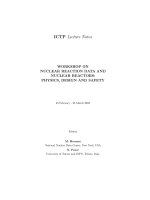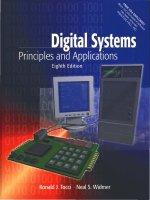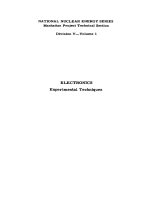Nuclear Energy: Principles, Practices, and Prospects doc
Bạn đang xem bản rút gọn của tài liệu. Xem và tải ngay bản đầy đủ của tài liệu tại đây (5.97 MB, 701 trang )
NUCLEAR
ENERGY
Springer
New York
Berlin
Heidelberg
Hong Kong
London
Milan
Paris
Tokyo
NUCLEAR
ENERGY
PRINCIPLES, PRACTICES, AND PROSPECTS
SECOND EDITION
David Bodansky
With 47 Figures
1
Springer
David Bodansky
Department of Physics
University of Washington
Seattle, WA 98195
USA
Library of Congress Cataloging-in-Publication Data
Bodansky, David.
Nuclear energy : principles, practices, and prospects / David Bodansky.—2nd ed.
p. cm.
Includes bibliographical references and index.
ISBN 0-387-20778-3 (hc : alk. paper)
1. Nuclear engineering. I. Title.
TK9145.B54 2003
333.792
4—dc22 2003070772
ISBN 0-387-20778-3 Printed on acid-free paper.
c
2004, 1996 Springer-Verlag New York, LLC.
AIP Press is an imprint of Springer-Verlag New York, LLC.
All rights reserved. This work may not be translated or copied in whole or in part with-
out the written permission of the publisher (Springer-Verlag New York, 175 Fifth Avenue,
New York, LLC, NY 10010, USA), except for brief excerpts in connection with reviews or
scholarly analysis. Use in connection with any form of information storage and retrieval, elec-
tronic adaptation, computer software, or by similar or dissimilar methodology now known
or hereafter developed is forbidden.
The use in this publication of trade names, trademarks, service marks, and similar terms,
even if they are not identified as such, is not to be taken as an expression of opinion as to
whether or not they are subject to proprietary rights.
Printed in the United States of America. (ING/MVY)
9 8 7 6 5 4 3 2 1 SPIN 10939710
Springer-Verlag is a part of Springer Science+Business Media
springeronline.com
Preface to the Second Edition
This second edition represents an extensive revision of the first edition, al-
though the motivation for the book and the intended audiences, as described
in the previous preface, remain the same. The overall length has been increased
substantially, with revised or expanded discussions of a number of topics, in-
cluding Yucca Mountain repository plans, new reactor designs, health effects
of radiation, costs of electricity, and dangers from terrorism and weapons pro-
liferation.
The overall status of nuclear power has changed rather little over the past
eight years. Nuclear reactor construction remains at a very low ebb in much
of the world, with the exception of Asia, while nuclear power’s share of the
electricity supply continues to be about 75% in France and 20% in the United
States. However, there are signs of a heightened interest in considering possible
nuclear growth. In the late 1990s, the U.S. Department of Energy began new
programs to stimulate research and planning for future reactors, and many
candidate designs are now contending—at least on paper—to be the next
generation leaders. Outside the United States, the commercial development
of the Pebble Bed Modular Reactor is being pursued in South Africa, a French-
German consortium has won an order from Finland for the long-planned EPR
(European Pressurized Water Reactor), and new reactors have been built or
planned in Asia.
In an unanticipated positive development for nuclear energy, the capacity
factor of U.S. reactors has increased dramatically in recent years, and most
operating reactors now appear headed for 20-year license renewals. In a nega-
tive development, the German and Dutch governments have announced plans
to phase out nuclear power and Sweden continues its earlier, but considerably
delayed, program to do the same. Further, it remains unlikely that private
U.S. companies will find it financially prudent to order new reactors without
incentives from the federal government.
Significant uncertainties remain in important areas, including the fate of
the Yucca Mountain nuclear waste repository project, the degree to which
v
vi Preface to the Second Edition
the U.S. government will act to further the construction new reactors, the
outcome of on-going debates on the effects of low doses of ionizing radiation,
and the extent to which nuclear weapons proliferation and nuclear terrorism
can be restrained. In the broader energy picture, concern about climate change
caused by fossil fuel combustion has intensified, with increased interest in the
potential of sequestering carbon dioxide after it is produced and in finding
alternatives to fossil fuels.
Given the uncertainties facing nuclear energy, including the overriding un-
certainty as to the extent that it may expand or contract, a new look at its
current status seems warranted. This book seeks to provide background for
considering the role that nuclear energy might play in addressing the over-
all energy dilemmas facing the United States and other countries throughout
the world. It also briefly discusses alternatives to nuclear energy, without
attempting a comparative evaluation of the competing, or complementary,
possibilities.
The preface to the first edition stated the hope that “the book will be
useful to readers with a wide variety of backgrounds who have an interest in
nuclear energy matters.” This was meant to include readers with technical
backgrounds and those without such backgrounds. With the latter readership
in mind, the somewhat mathematically oriented material has been slightly
reduced for this edition. I hope that where uncongenial equations are found
(now mostly confined to Chapter 7), readers will be able to skip over them
without too much loss of basic content.
Again, I am indebted to many individuals, at the University of Washington
and elsewhere, for much appreciated help. The debts that were acknowledged
in the first edition remain. For this edition, assistance from a number of addi-
tional individuals calls for special mention. Robert Albrecht, at the University
of Washington, has read and discussed many parts of the book with me, and
has given me the benefit of his deep understanding of nuclear matters. Robert
and Susan Vandenbosch, also in Seattle, have reviewed virtually the entire
manuscript and have made numerous helpful suggestions. Edwin Kolbe, the
Project Manager for Radioactive Materials at the Swiss National Cooperative
for the Disposal of Radioactive Waste (NAGRA) and a 2002 visitor at the
Institute for Nuclear Theory at the University of Washington, kindly offered
to carry out ORIGEN calculations that give the yield of radionuclides in “typ-
ical” spent fuel. Abraham Van Luik, with the Yucca Mountain Project, has
provided valuable help in elucidating the DOE’s planning and analyses for the
project.
Many other colleagues have read drafts of one or more chapters and I am
grateful to them for their comments on those chapters, and in many cases,
on other aspects of the book. I here thank: Chaim Braun, Bernard Cohen,
Stanley Curtis, J. Gregory Dash, David Hafemeister, Isaac Halpern, Robert
Halvorsen, William Sailor, Luther Smith, and Gene Woodruff. I also am grate-
ful to Edward Gerjuoy, Phillip Malte, Jeffrey Schneble, and Donald Umstadter
for comments on the first edition.
Preface to the Second Edition vii
It is not possible to give a full listing of all the other individuals who have
assisted me with information, advice, and documents. In this regard, in ad-
dition to those acknowledged above and in the first edition, I want at least
to thank Joseph Beamon, James Beard, Mario Carelli, Yoon Chang, Ray-
mond Clark, Paul Craig, George Davis, Herbert Ellison, Rodney Ewing, Tom
Ferriera, Steve Fetter, Brittain Hill, Mark Jacobson, John Kessler, Kristian
Kunert, Edward Miles, Thomas Murley, Richard Poeton, Jerome Puskin, Low-
ell Ralston, Stanley Ritterbusch, Finis Southworth, John Taylor, Ronald Vi-
juk, David Wade, Kevan Weaver, Ruth Weiner, Bruce Whitehead, Bertram
Wolfe, and Joseph Ziegler.
Again, as in the first edition, my thanks and apologies are extended to the
many others, not named above, who have generously given me their help. I ap-
preciate the willingness of the University of Washington and the Department
of Physics to provide space, facilities, and a congenial working environment.
Finally, again, I wish to thank my wife, Beverly, for her patience and support
during the long continuation of an effort that seemed at times to belie the
concept of retirement.
Seattle, Washington David Bodansky
May 2004
Preface to the First Edition
This book has evolved from notes prepared for students in a physics course
designed to cover the major aspects of energy production and consumption.
About one-third of the course dealt with nuclear energy, and the notes for
that segment were revised and expanded for the present book.
The course assumed that the students had at least one year of college-
level physics, thus permitting the inclusion of some technical discussions. The
present book, in its occasional use of equations and technical terminology,
somewhat reflects the nature of that original audience. Readers with relatively
little background in physics and engineering may find it useful to refer to the
Appendix on “Elementary Aspects of Nuclear Physics,” and to the Glossary.
I have sometimes been asked: “For whom is the book written?” One diffi-
culty in addressing this question has already been touched on. Some of the
technical discussions include equations, which is not customary in a book for a
“lay audience.” Other parts are more elementary than would be the case were
this a textbook on nuclear engineering. Nonetheless, most of the key issues can
be constructively discussed using little or no mathematical terminology, and
I therefore hope that the book will be useful to readers with a wide variety of
backgrounds who have an interest in nuclear energy matters.
A more fundamental difficulty lies in the fact that such interest is now at a
low ebb. In fact, it is often believed that the era of nuclear fission energy has
passed, or is passing. While most informed people are aware that France is
highly dependent on nuclear energy, this is ignored as an aberration, holding
little broader significance. It is not widely realized that nuclear energy, despite
its stagnancy in the United States and most of Europe, is expanding rapidly
in Asia. Further, many people who are otherwise well-informed on issues of
public policy are surprised to learn that the United States now obtains more
than 20% of its electricity from nuclear power.
This book has been written in the belief that it is premature and probably
incorrect to assume that there is to be only one era of nuclear power and
that this era has passed. The future pattern of nuclear energy use will depend
on developments in a variety of energy technologies and on public attitudes
ix
x Preface to the First Edition
in differing countries. There can be little certainly as to how these develop-
ments will unfold. However, the demands of a growing world economy and
the pressures of declining availability of oil will inevitably force a realignment
and reassessment of energy options. The goal of this book is to provide basic
information to those who want to gain, or refresh, an introductory familiarity
with nuclear power, even before broad new reassessments of energy policy are
made in the United States and elsewhere.
The preparation of the book has been aided by contributions from many
individuals. Among these, I would like especially to acknowledge three. Since
I first became interested in energy issues some twenty years ago and continu-
ing until his death in 1991, my understanding of these issues and of nuclear
energy in particular benefited greatly from discussions and collaborative writ-
ing with my colleague Fred Schmidt. Over the years, I have also gained much
from the wisdom of Alvin Weinberg, who has made unique contributions to
nuclear energy and its literature and, most recently, has very kindly read and
commented on much of this manuscript. I am also grateful to Peter Zimmer-
man who served the publisher as an anonymous reviewer of a preliminary
draft of this book and who subsequently, anonymity discarded, has been a
very constructive critic of a revised draft.
In addition, I am heavily indebted to many other individuals at the Uni-
versity of Washington, in government agencies, in industry, and elsewhere.
Some have been generous in aiding with information and insights, some have
commented on various chapters as the book has evolved, and some have done
both. Without attempting to distinguish among these varied contributions,
I particularly wish to thank Mark Abhold, Thomas Bjerdstedt, Robert Bud-
nitz, Thomas Buscheck, J. Gregory Dash, Kermit Garlid, Ronald Geballe,
Marc Gervais, Emil Glueckler, Lawrence Goldmuntz, Isaac Halpern, Charles
Hyde-Wright, William Kreuter, Jerrold Leitch, Norman McCormick, Thomas
Murley, James Quinn, Maurice Robkin, Margaret Royan, Mark Savage, Jean
Savy, Fred Silady, Bernard Spinrad, Ronald Vijuk, and Gene Woodruff.
This list is far from exhaustive and I extend my thanks and apologies to the
many others whom I have failed to mention. I am also grateful to the Univer-
sity of Washington and the Department of Physics for making it possible for
me to teach the courses and devote the time necessary for the development
of this book. Finally, I must express my appreciation to my wife, Beverly, for
her support and encouragement as the book progressed.
Contents
Preface to the Second Edition v
Preface to the First Edition ix
1 The Motivation for Nuclear Energy 1
1.1 TheNeed forEnergySources 1
1.1.1 The Importanceof Energy 1
1.1.2 EnergyUsePatterns 2
1.1.3 The RoleofElectricity 4
1.2 ProblemswithFossilFuels 7
1.2.1 The NeedtoReplace FossilFuels 7
1.2.2 Limitations on Fossil Fuel Supplies . . . 8
1.2.3 GlobalClimateChange 11
1.3 Nuclear Power as a Substitute for Fossil Fuels 14
1.3.1 AlternativestoFossilFuels 14
1.3.2 The PotentialRoleof NuclearEnergy 17
1.3.3 The ExampleofFrance 18
1.3.4 The StatusofNuclear Energy 18
References 22
2 Nuclear Power Development 25
2.1 PresentStatusofNuclearPower 25
2.2 EarlyHistory ofNuclearEnergy 27
2.2.1 SpeculationsBefore theDiscoveryof Fission 27
2.2.2 Fission andtheFirst Reactors 29
2.3 Developmentof NuclearPowerinthe UnitedStates 31
2.3.1 ImmediatePostwarDevelopments 31
2.3.2 HistoryofU.S.ReactorOrdersandConstruction 33
2.3.3 Reactor Cancellations 36
xi
xii Contents
2.4 Trends in U.S. Reactor Utilization . . . 36
2.4.1 Permanent Reactor Closures 36
2.4.2 CapacityFactors 39
2.4.3 Consolidation in the U.S. Nuclear Industry . . . 41
2.4.4 Renewalof Reactor OperatingLicenses 41
2.5 WorldwideDevelopmentofNuclear Power 42
2.5.1 Early History of Nuclear Programs . . . 42
2.5.2 Nuclear Power Since 1973 43
2.5.3 PlannedConstructionofNewReactors 45
2.6 National Programs of Nuclear Development . . 47
2.6.1 France 47
2.6.2 Japan 48
2.6.3 Other Countries 49
2.7 Failures of Prediction 53
References 54
3 Radioactivity and Radiation Exposures 57
3.1 BriefHistory 57
3.2 RadiationDoses 58
3.2.1 Radiation Exposureand RadiationDose 58
3.2.2 Basic UnitsofExposureand Dose 59
3.2.3 EffectiveDoseEquivalentor EffectiveDose 62
3.3 RadioactiveDecay 63
3.3.1 Half-life and Mean Life . 63
3.3.2 UnitsofRadioactivity 64
3.3.3 SpecificActivity 65
3.4 NaturalRadioactivity 66
3.4.1 Origin ofNaturalRadioactivity 66
3.4.2 RadioactiveSeriesin Nature 68
3.4.3 Concentrations of Radionuclides in the Environment . . . 70
3.5 SurveyofRadiationExposures 73
3.5.1 Natural SourcesofRadiation 73
3.5.2 Radiation DosesfromMedicalProcedures 77
3.5.3 Other SourcesofRadiation 78
3.5.4 Summary 81
References 82
4 Effects of Radiation Exposures 85
4.1 TheStudy ofRadiationEffects 85
4.1.1 Agencies and Groups Carrying out Radiation Studies . . 85
4.1.2 Types of Studies 86
4.1.3 Types of Effects: Deterministic and Stochastic 87
4.2 Effectsof HighRadiationDoses 87
4.2.1 Deterministic Effects 87
Contents xiii
4.2.2 Stochastic Effects: Observational Evidence for Cancer
atHighDoses 88
4.3 Effectsof LowRadiationDoses 91
4.3.1 Importance ofLowDoses 91
4.3.2 Observational Evidence for Cancer at Low Dose
Rates 92
4.3.3 The Shapeof theDose–ResponseCurve 96
4.3.4 Conclusions of Advisory Bodies on Low-Dose Effects . . . 100
4.3.5 GeneticEffects 104
4.4 RadiationStandardsandHealthCriteria 105
4.4.1 Standards for the General Public 105
4.4.2 StandardsforOccupationalExposures 107
4.4.3 AlternativeRiskCriteria 108
4.4.4 Collective Doses and de Minimis Levels 110
4.5 Radionuclides of Special Interest 111
4.5.1 Radium-226 . 111
4.5.2 Radon-222 112
4.5.3 Neptunium-237 115
References 118
5 Neutron Reactions 123
5.1 OverviewofNuclearReactions 123
5.1.1 Neutron ReactionsofImportance inReactors 123
5.1.2 Reaction CrossSections 125
5.1.3 Neutron ReactionsinDifferentEnergyRegions 128
5.2 CrossSectionsin theResonanceRegion 128
5.2.1 ObservedCrossSections 128
5.2.2 ShapeoftheResonancePeak 130
5.2.3 Level Widths and Doppler Broadening 131
5.3 CrossSectionsin theContinuumRegion 132
5.4 TheLow-EnergyRegion 134
5.4.1 Low-Energy Region and the 1/v Law 134
5.4.2 ThermalNeutrons 134
References 136
6 Nuclear Fission 139
6.1 Discoveryof Fission 139
6.2 SimplePictureofFission 141
6.2.1 CoulombandNuclear Forces 141
6.2.2 Separation Energies and Fissionability 141
6.2.3 Fission Cross Sections with Fast and Thermal
Neutrons 143
6.3 Productsof Fission 144
6.3.1 Mass Distribution of Fission Fragments 144
xiv Contents
6.3.2 Neutron Emission 146
6.3.3 Decay of Fission Fragments . . . 148
6.4 EnergyRelease inFission 149
6.4.1 Energy of Fission Fragments . . 149
6.4.2 TotalEnergyBudget 150
References 151
7 Chain Reactions and Nuclear Reactors 153
7.1 Criticality and the Multiplication Factor 153
7.1.1 General Considerations 153
7.1.2 Formalism for Describing the Multiplication Factor 155
7.1.3 Numerical Values of Thermal Reactor Parameters 157
7.2 Thermalizationof Neutrons 158
7.2.1 Role ofModerators 158
7.2.2 ModeratingRatio 160
7.3 ReactorKinetics 162
7.3.1 Reactivity 162
7.3.2 Buildup of Reaction Rate 162
7.4 Conversion Ratio and Production of Plutonium in Thermal
Reactors 164
7.5 ControlMaterialsandPoisons 166
7.5.1 Reactor Poisons 166
7.5.2 Controls 166
7.5.3 Xenon Poisoning 167
References 168
8 Types of Nuclear Reactors 171
8.1 SurveyofReactorTypes 171
8.1.1 Uses ofReactors 171
8.1.2 ClassificationsofReactors 172
8.1.3 ComponentsofConventionalReactors 173
8.1.4 WorldInventoryof ReactorTypes 176
8.2 LightWaterReactors 181
8.2.1 PWRsandBWRs 181
8.2.2 ComponentsofaLightWater Reactor 181
8.2.3 PWR Reactor Cores 185
8.3 Burners,Converters, andBreeders 186
8.3.1 Characterization of Reactors . . 186
8.3.2 Achievement of High Conversion Ratios in Thermal
Reactors 186
8.3.3 FastBreederReactors 188
8.4 TheNatural Reactor atOklo 191
References 192
Contents xv
9 Nuclear Fuel Cycle 193
9.1 Characteristics of the Nuclear Fuel Cycle 193
9.1.1 TypesofFuelCycle 193
9.1.2 Steps intheNuclear FuelCycle 195
9.2 FrontEnd oftheFuelCycle 195
9.2.1 Uranium Mining and Milling . . 195
9.2.2 Enrichment of Uranium 198
9.2.3 FuelFabrication 204
9.2.4 Other FuelTypes 205
9.3 Fuel Utilization 205
9.3.1 Burnup as a Measure of Fuel Utilization . 205
9.3.2 Uranium Consumption and Plutonium Production . 208
9.3.3 EnergyfromConsumptionofFuel 210
9.3.4 Uranium Ore Requirement . . . 212
9.4 BackEndofFuelCycle 213
9.4.1 Handling of Spent Fuel . 213
9.4.2 Reprocessing 214
9.4.3 Alternative Reprocessing and Fuel Cycle Candidates . . . 218
9.4.4 WasteDisposal 220
9.5 Uranium Resources . 221
9.5.1 Price of Uranium . . . . 221
9.5.2 Estimates of Uranium Resources 222
9.5.3 Uranium from Seawater 225
9.5.4 Impact of Fuel Cycle Changes and Breeder Reactors . . . 226
References 227
10 Nuclear Waste Disposal: Amounts of Waste 231
10.1 Categories of Nuclear Waste 231
10.1.1 TheNatureoftheProblem 231
10.1.2 Military and Civilian Wastes . . 232
10.1.3 High-and Low-LevelWastes 233
10.1.4 InventoriesofU.S. NuclearWastes 234
10.1.5 Measuresof WasteMagnitudes 235
10.2 Wastesfrom Commercial Reactors 237
10.2.1 Massand Volumeper GWyr 237
10.2.2 Radioactivity inWasteProducts 238
10.2.3 HeatProduction 242
10.3 HazardMeasuresforNuclear Wastes 244
10.3.1 Approaches to Examining Hazards 244
10.3.2 Comparisons Based on Water Dilution Volume 245
10.3.3 Comparisons of Activity in Spent Fuel and in Earth’s
Crust 249
References 251
xvi Contents
11 Storage and Disposal of Nuclear Wastes 253
11.1 Stages in Waste Handling . . 253
11.1.1 Overview of Possible Stages . . . 253
11.1.2 Storage of Spent Fuel at Reactor Sites 254
11.1.3 Interim Storage of Waste or Spent Fuel
at Centralized Facilities 257
11.1.4 NuclearWasteTransportation 260
11.2 DeepGeologicDisposal 266
11.2.1 Multiple Barriers in Geologic Disposal 266
11.2.2 AlternativeHostRocksforaGeologicRepository 267
11.2.3 Motion of Water and Radionuclides
Through Surrounding Medium 269
11.2.4 Thermal Loading of the Repository . . . 272
11.2.5 TheWastePackage 273
11.3 Alternativesto DeepGeologicDisposal 277
11.3.1 Variantsof GeologicDisposal 277
11.3.2 Subseabed Disposal . . 278
11.3.3 Partitioning and Transmutation of Radionuclides 281
11.3.4 Summary of Status of Alternatives to Geologic
Disposal 285
11.4 WorldwideStatusofNuclearWasteDisposalPlans 285
References 287
12 U.S. Waste Disposal Plans and the Yucca Mountain
Repository 291
12.1 FormulationofU.S.WasteDisposalPolicies 291
12.1.1 Brief History of Planning Efforts 291
12.1.2 Organizations Involved in Waste Management Policy. . . 293
12.1.3 CongressionalRoleintheSite-SelectionProcess 296
12.2 ThePlannedYuccaMountainRepository 297
12.2.1 Schedule for the Yucca Mountain Project . 297
12.2.2 PhysicalFeaturesoftheSite 299
12.2.3 TheWasteInventory 301
12.2.4 TheNuclear WasteFund 302
12.3 Protective Barriers in Repository Planning . . 303
12.3.1 TheProtectionRequirement 303
12.3.2 Defense-in-Depth 304
12.3.3 Engineered Barriers . . 305
12.3.4 Natural Barriers 308
12.3.5 The Thermal Loading of the Repository 311
12.4 TotalSystem PerformanceAssessments 312
12.4.1 The TSPA Approach 312
12.4.2 TheDOENominal Scenario 316
12.4.3 DisruptiveScenarios 320
12.4.4 EPRI’sTSPACalculations 324
Contents xvii
12.5 ResolvingQuestionsAboutthe RepositoryPerformance 326
12.5.1 Evaluationsof YuccaMountainAnalyses 326
12.5.2 Continuing Technical Issues . . . 329
12.5.3 FurtherInstitutionalMeasures 330
12.5.4 OverviewofYuccaMountainProspects 331
References 332
13 Policy Issues in Nuclear Waste Disposal 337
13.1 TheImportance oftheNuclearWasteDisposalIssue 337
13.1.1 TheCentrality oftheIssue 337
13.1.2 GeneralConsiderationsin NuclearWasteDisposal 338
13.2 EPAStandardsforNuclearWasteDisposal 339
13.2.1 TheOriginalFormulationof40CFR191 339
13.2.2 The
14
CProblem 340
13.2.3 TheOverturnof10CFR191 342
13.2.4 TheNAS Recommendations 342
13.2.5 EPA’s 2001 Standards: 40CFR197 344
13.3 Responsibilities to Future Generations 347
13.3.1 TheGeneralRecognitionof theProblem 347
13.3.2 Pictureof FutureGenerations 349
13.3.3 DiscountingwithTime 351
13.4 SpecialIssues inConsideringWasteDisposal 353
13.4.1 TheDecision-MakingProcess 353
13.4.2 Technological Optimism and Its Possible Traps . 357
13.4.3 A Surrogate Issue? . . 358
13.5 Possible Approaches to Nuclear Waste Disposal 359
13.5.1 A Step-by-Step Approach 359
13.5.2 Framework for Considering Intergenerational
Responsibilities 362
13.5.3 PuttingtheRisks intoPerspective 363
References 367
14 Nuclear Reactor Safety 371
14.1 GeneralConsiderationsinReactor Safety 371
14.1.1 Assessments ofCommercialReactorSafety 371
14.1.2 TheNatureofReactorRisks 372
14.1.3 Meansof AchievingReactor Safety 374
14.1.4 Measuresof HarmandRiskinReactorAccidents 377
14.2 AccidentsandtheirAvoidance 379
14.2.1 CriticalityAccidents andFeedbackMechanisms 379
14.2.2 HeatRemovalandLoss-of-CoolantAccidents 381
14.3 EstimatingAccidentRisks 383
14.3.1 Deterministic Safety Assessment 383
14.3.2 Probabilistic Risk Assessment . 384
14.3.3 Resultsof theReactorSafetyStudy 389
xviii Contents
14.4 Post-TMISafetyDevelopments 392
14.4.1 InstitutionalResponses 392
14.4.2 1990 NRC Analysis: NUREG-1150 . . . . 393
14.4.3 Predictions of Core Damage and Precursor Analyses . . . 399
14.4.4 Other Indications of Performance . 401
14.5 ReactorSafetyStandards 403
14.5.1 U.S.NuclearRegulatoryCommissionPosition 403
14.5.2 StandardsAdoptedbyOther Bodies 407
14.5.3 Standards for Future Reactors: How Safe Is Safe
Enough? 407
References 408
15 Nuclear Reactor Accidents 411
15.1 HistoricalOverviewofReactorAccidents 411
15.2 TheThreeMile IslandAccident 414
15.2.1 TheEarly HistoryoftheTMIAccident 414
15.2.2 EvolutionoftheTMI Accident 417
15.2.3 Effectsof theTMIAccident 418
15.3 TheChernobylAccident 421
15.3.1 TheChernobylReactors 421
15.3.2 HistoryoftheChernobylAccident 422
15.3.3 Releaseof Radioactivityfrom Chernobyl 425
15.3.4 Observations of Health Effects of Chernobyl Accident . . 426
15.3.5 Radiation Exposures at Chernobyl and Vicinity 428
15.3.6 WorldwideRadiationExposuresfrom Chernobyl 432
15.3.7 GeneralEffectsoftheChernobylAccident 434
References 436
16 Future Nuclear Reactors 439
16.1 GeneralConsiderationsforFutureReactors 439
16.1.1 TheEnd oftheFirst EraofNuclear Power 439
16.1.2 Important Attributes of Future Reactors 440
16.1.3 ReactorSize 441
16.1.4 U.S.LicensingProcedures 443
16.2 SurveyofFutureReactors 444
16.2.1 ClassificationofReactors byGeneration 444
16.2.2 U.S.DOE Near-TermDeployment Roadmap 445
16.2.3 Illustrative Compilations of Reactor Designs . . 448
16.3 Individual Light Water Reactors . 449
16.3.1 EvolutionaryReactorsLicensedbytheU.S.NRC 449
16.3.2 InnovativeLightWaterReactors 452
16.4 High-Temperature,Gas-CooledReactors 459
16.4.1 HTGROptions 459
16.4.2 Historical Background of Graphite-Moderated
Reactors 460
Contents xix
16.4.3 GeneralFeaturesof PresentHTGR Designs 462
16.4.4 HTGRConfigurations 464
16.5 Liquid-Metal Reactors 467
16.5.1 Recent United States Programs 467
16.5.2 SafetyFeatures ofLMRs 468
16.6 The Generation IV Program 470
16.6.1 Overview of the Program 470
16.6.2 SystemsEmphasizedin theUnitedStates 472
16.7 RadicalNuclearAlternativestoPresentReactors 475
16.7.1 Fusion 475
16.7.2 Accelerator-Driven Fission 476
References 477
17 Nuclear Bombs, Nuclear Energy, and Terrorism 481
17.1 Concerns About Links Between Nuclear Power and Nuclear
Weapons 481
17.2 NuclearExplosions 482
17.2.1 Basic Characteristics of Fission Bombs 482
17.2.2 Effectsof NuclearBombs 485
17.2.3 CriticalMassforNuclearWeapons 486
17.2.4 Buildup of a Chain Reaction . . 489
17.3 Uranium and Nuclear Weapons 490
17.4 Plutonium and Nuclear Weapons 492
17.4.1 Explosive Properties of Plutonium . . . . 492
17.4.2 Reactor-Grade Plutonium as a Weapons Material 496
17.4.3 Production of Plutonium in Reactors . 499
17.5 Terrorist Threats . . . 501
17.5.1 The Range of Terrorist Threats 501
17.5.2 The Nature of the Nuclear Terrorist Threat . . . 503
17.5.3 NuclearBombs 504
17.5.4 RadiologicalDispersionDevices (“DirtyBombs”) 510
17.5.5 Attackson NuclearPowerPlants 512
References 514
18 Proliferation of Nuclear Weapons 517
18.1 Nuclear Proliferation . 517
18.1.1 InternationalTreaties 517
18.1.2 Forms of Proliferation . 522
18.1.3 Means for Obtaining Fissile Material . . 524
18.1.4 NuclearWeaponsInventories 525
18.2 HistoryofWeapons Development 526
18.2.1 OfficialNuclear-WeaponStates 526
18.2.2 Other Countries with Announced Weapons
Programs 530
xx Contents
18.2.3 Countries Believed to Have or Be Seeking Nuclear
Weapons 533
18.2.4 Countries That Have Abandoned Nuclear
Weapons Programs . . 539
18.2.5 SummaryofPathwaystoWeapons 542
18.3 NuclearPowerandtheWeaponsThreat 542
18.3.1 Potential Role of Nuclear Power in Weapons
Proliferation . 542
18.3.2 Weapons Dangers for Different Categories of
Countries 545
18.3.3 Reducing Proliferation Dangers from Nuclear Power . . . 548
18.3.4 Nuclear Power and Moderation of Weapons Dangers . . . 550
18.3.5 PolicyOptionsforthe UnitedStates 554
References 555
19 Costs of Electricity 559
19.1 GenerationCostsandExternalCosts 559
19.2 InstitutionalRoles 561
19.2.1 WhoProvidesElectricity? 561
19.2.2 The Role of Government in Electricity
GenerationDecisions 563
19.3 TheGenerationCostofElectricity 564
19.3.1 CalculationofCosts 564
19.3.2 Recent Trends in Electricity Prices . . . 566
19.3.3 Costsof NuclearandFossilFuelElectricitySources 567
19.4 CostsandElectricityChoices 571
19.4.1 TheRole ofCostDifferences 571
19.4.2 Leveling or Tilting the Playing Field . . 572
19.4.3 Mechanisms for Encouraging or Discouraging
ElectricityChoices 574
19.4.4 ReactorLongevity 575
References 576
20 The Prospects for Nuclear Energy 579
20.1 TheNuclearDebate 579
20.1.1 NatureoftheDebate 579
20.1.2 InternalFactorsImpactingNuclearPower 581
20.1.3 ExternalFactorsImpactingNuclear Energy 581
20.2 OptionsforElectricityGeneration 582
20.2.1 Need for Additional Generating Capacity . 582
20.2.2 Fossil Fuels with Low CO
2
Emissions 583
20.2.3 RenewableSources 585
20.2.4 Fusion 589
20.3 Possible Expansion of Nuclear Power . 589
20.3.1 ProjectionofDemand 589
Contents xxi
20.3.2 Production of Hydrogen . 592
20.3.3 Desalination of Seawater 595
20.3.4 Possible Difficulties in Nuclear Expansion 597
20.4 RegionalProspectsforNuclearPowerDevelopment 600
20.4.1 WorldPicture 600
20.4.2 UnitedStates 600
20.4.3 Asia 603
20.5 IssuesinNuclearDecisions 605
20.5.1 Categories of Issues . . 605
20.5.2 Proliferation Risks and Nuclear Power 606
20.5.3 NuclearPowerand aDesirableSociety 607
20.5.4 TheRoadtoDecisions 610
20.5.5 Predictionsandtheir Uncertainty 613
References 615
A Elementary Aspects of Nuclear Physics 619
A.1 SimpleAtomicModel 619
A.1.1 AtomsandTheir Constituents 619
A.1.2 AtomicNumberand MassNumber 620
A.1.3 IsotopesandIsobars 620
A.2 UnitsinAtomicandNuclear Physics 621
A.2.1 Electric Charge 621
A.2.2 Mass 621
A.2.3 Avogadro’s Number and the Mole 622
A.2.4 Energy 623
A.2.5 Mass–EnergyEquivalence 623
A.3 AtomicMasses andEnergyRelease 624
A.3.1 AtomicMassand AtomicMassNumber 624
A.3.2 IsotopesandElements 624
A.3.3 Binding Energy, B 625
A.3.4 EnergyRelease inNuclearProcesses 626
A.4 EnergyStatesand Photons 626
A.5 NuclearSystematics 628
A.6 RadioactiveDecayProcesses 630
A.6.1 ParticlesEmittedinRadioactiveDecay 630
A.6.2 Alpha-Particle Emission 631
A.6.3 Beta-ParticleEmission 633
A.6.4 Gamma-Ray Emission 635
A.7 RateofRadioactiveDecay 636
A.7.1 ExponentialDecay 636
A.7.2 MeanLifeandHalf-Life 636
A.7.3 Nuclei Remaining after a Given Time Interval 637
A.7.4 DecayChains 638
References 639
xxii Contents
B General Tables 641
Acronyms and Abbreviations 647
Glossary 655
Index 675
1
The Motivation for Nuclear Energy
1.1 The Need for Energy Sources 1
1.2 Problems with Fossil Fuels 7
1.3 Nuclear Power as a Substitute for Fossil Fuels 14
References 22
1.1 The Need for Energy Sources
1.1.1 The Importance of Energy
The discovery and exploitation of new sources of energy has been central
to human progress from the early struggle for biological survival to today’s
technological world. The first step was learning to control fire, with wood or
other biomass as the fuel. This was followed by the harnessing of wind for
ships and windmills, the use of water power from rivers, and—mostly much
later—the exploitation of chemical energy from the burning of coal, oil, and
natural gas. Nuclear energy, which first emerged in the middle of the 20th
century, is the latest energy source to be used on a large scale.
It is often pointed out that this has not all been “progress.” Some human
activities are harmful to other people, to other species, and to the environ-
ment, and technological advances enable us to inflict damage more rapidly
and on a larger scale than would otherwise be possible. It is also sometimes
argued that our lives would be more satisfying if our material surroundings
were less complex and changed less rapidly.
Nonetheless, most people in the developed countries gladly accept the
fruits of technological advances, and people in less prosperous countries aspire
to catch up. While the burden of inefficient or unnecessary energy consump-
tion may be reduced, it is unlikely that there will be a consensus favoring
a substantial reduction in energy use in most of the developed countries or
a voluntary stemming of the rise of energy use in the developing ones, with
their growing population and—it is to be hoped—improved living standards.
Thus, the world will demand increasing supplies of energy during the 21st
century. Nuclear power provides one option for supplying this energy, albeit
a controversial one.
1
2 1 The Motivation for Nuclear Energy
Table 1.1. Commercial energy sources: World consumption in 2001 and U.S.
consumption in 2002.
Source World (2001) United States (2002)
Quads Percent Quads Percent
Fossil fuels
Petroleum 156 39 38.4 39
Coal 96 24 22.2 23
Natural gas 93 23 23.2 24
All fossil fuels 346 86 83.8 86
Renewable sources
a
Hydroelectric 27 6.6 2.6 2.6
Other renewable 3
b
0.8 3.2 3.3
All renewable 30 7.4 5.8 6
Nuclear 26 6.5 8.1 8.3
TOTAL 397 100 98 100
a
The reported renewable energy is used mainly for electricity generation, calculated
(except for geothermal power) at the average primary energy rate for fossil-fuel
steam plants (10,201 BTU/kWh) [1].
b
The world total for “other renewable” energy is an underestimate, because it in-
cludes only energy used for electricity generation, and thus omits other uses, partic-
ularly the burning of biomass for heat (wood and wastes).
Source: Refs. [1] and [2].
1.1.2 Energy Use Patterns
Sources of Energy
For well over 100 years, the dominant energy sources in the industrialized
world have been fossil fuels—coal, oil, and natural gas—and these now dom-
inate in most of the developing world as well. Other major contributors, of
varying importance in different countries, include hydroelectric power, nuclear
power, and biomass.
1
Table 1.1 indicates the main sources of energy for the United States and
the world.
2
The dominance of fossil fuels is brought out in these data. They
provide 86% of the primary energy for both the United States and the world.
The remainder is divided between nuclear and renewable sources. The most
1
The magnitude of biomass consumption is difficult to establish accurately, be-
cause much of it involves the collection of wood and wastes on an individual or
small-scale basis, outside of commercial channels. Its use is therefore less well
documented than is the use of fuels that are purchased commercially.
2
Here, we follow the practice of U.S. Department of Energy publications, which
report energy in BTU or quads, where 1 BTU = 1055 joules (J) and 1 Quad =
10
15
BTU = 1.055 × 10
18
J=1.055 exajoule (EJ).
1.1 The Need for Energy Sources 3
important renewable source in commercial energy channels is hydroelectric
power. Biomass is included in the U.S. renewable data, but for the world data
the only biomass included is the small amount used in electricity generation.
Disparities Among Countries
The disparities among countries are great. In 2001, the per capita consumption
of energy for industrialized countries such as France and Japan was about 14
times that of India and almost 50 times that of Bangladesh, whereas it was
only about one-half that of the United States [3]. It might be desirable and
practical for the United States to reduce its per capita energy use, but in many
countries there is a need for more energy. In fact, although the gap between
the extremes is still very large, some progress in reducing it has been made
in recent years. Thus, U.S. energy consumption per capita hardly changed
from 1980 to 2001, whereas per capita consumption more than doubled for
India and rose over 150% for Bangladesh—a considerable accomplishment,
especially considering the substantial population growth in those countries.
An “overnight” doubling of world energy consumption (i.e., a doubling
with no increase in population) would still leave the world’s average per capita
rate less than 40% of the U.S. rate, with many countries well below the new av-
erage. To accommodate an increasing population and an increased per capita
demand in much of the world, world energy production may have to more
than double over the next 50 years [4, 5]. If present trends continue, most of
this additional energy will come from fossil fuels.
Growth of Energy Use in the United States
The history of energy use in the United States since World War II can be
divided into two epochs: a period of rapid and unconcerned rise until the oil
embargo of 1973 and a subsequent period of much slower growth. Overall, the
entire period has been marked by a substantial increase in energy use and an
even more rapid increase in electricity use. Figure 1.1 shows the growth from
1949 to 2002 in U.S. population, total energy use, gross domestic product (in
constant dollars), and electricity use.
From 1949 to about 1975, total energy consumption closely tracked the
gross domestic product (GDP) but in subsequent years it lagged GDP sub-
stantially, apparently due to more efficient use of energy and the lessening
relative importance of heavy industry in the U.S. economy.
During the same early period, the growth in electricity demand outstripped
that of energy and GDP, with average annual growth rates of about 10% from
1949 to 1959 and 7% from 1959 to 1973. Since 1973, electricity growth has
continued, but at the relatively modest average annual rate of 2.7% for the
1973–2002 period. This rate is close to, but slightly below, the rate for GDP
growth in this period (2.9%) and substantially exceeds the rate for energy
consumption (0.9%).









